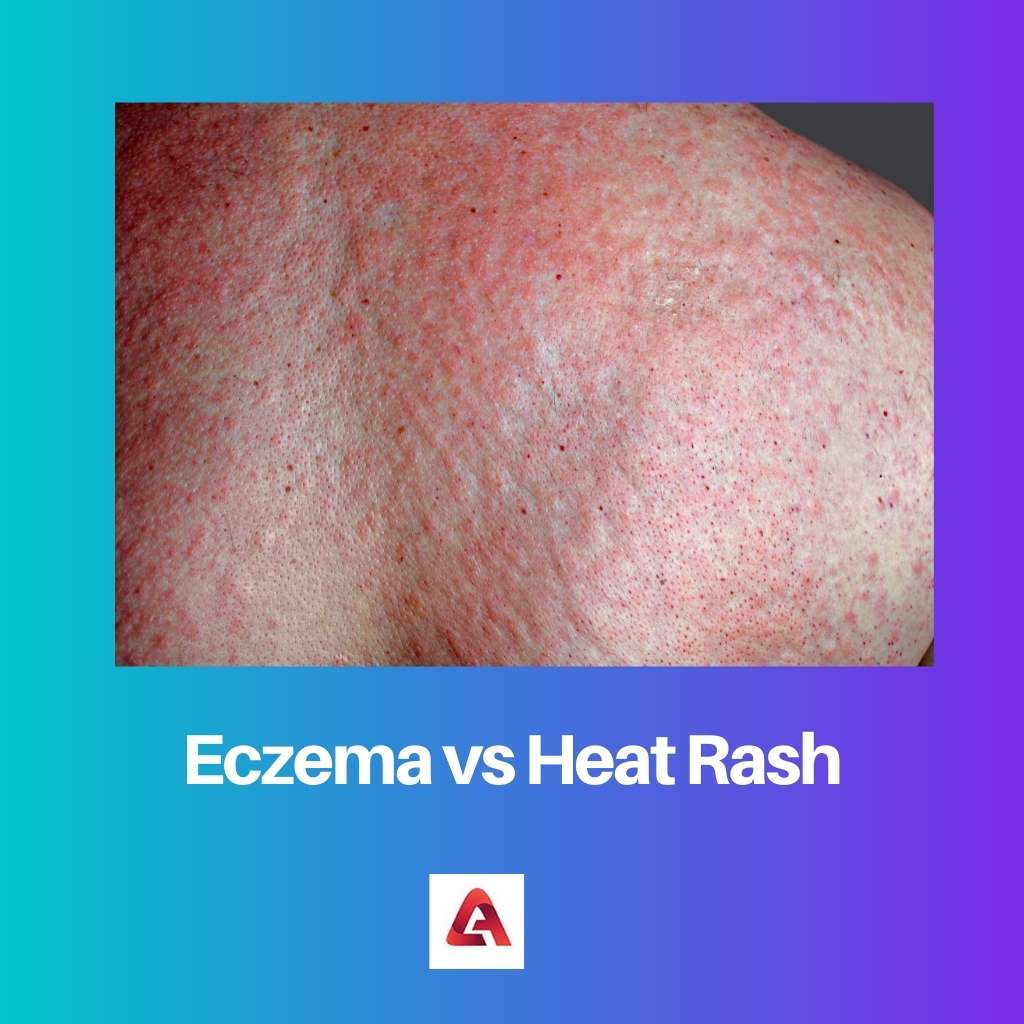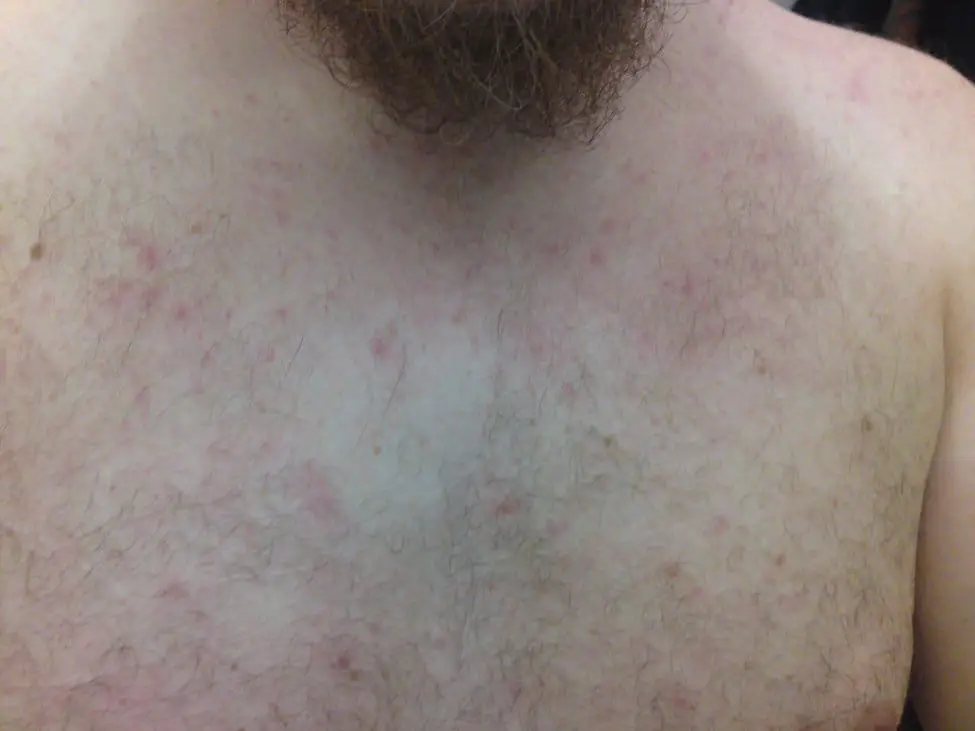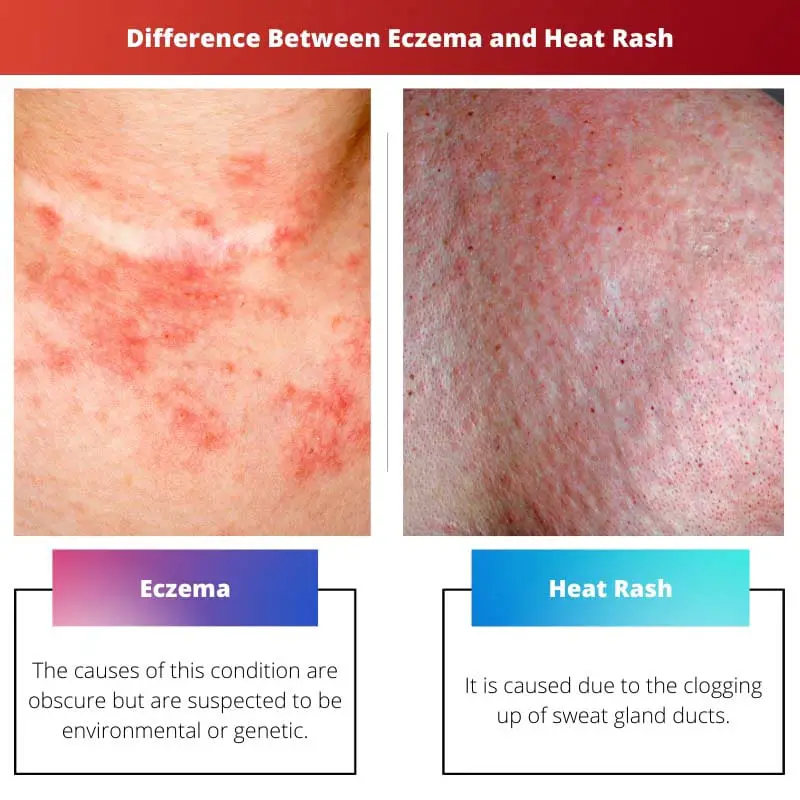Skin conditions are a genuine problem that affects many people across the world. Even toddlers are prone to be diagnosed by them. Eczema and heat rash are two different skin conditions most common among adults and children. However, recognizing each of them can be an arduous task.
Key Takeaways
- Eczema stems from an overactive immune system and skin barrier dysfunction, while heat rash arises from blocked sweat glands.
- Eczema causes chronic, itchy skin patches, whereas heat rash results in small, itchy red bumps.
- Eczema needs long-term management and treatment, but heat rash resolves independently with proper cooling and ventilation.
Eczema vs Heat Rash
Eczema is a skin condition due to immune dysfunction or allergies resulting in chronic inflammation. It causes itching and needs to be treated properly to get rid of it. Heat rash occurs when sweat ducts get blocked, which affects sweat movement to the skin. It dies on its own.

Eczema most commonly goes by the name ‘Dermatitis. It is a condition that causes inflammation of the skin, leading to redness, itching, and even rashes. In the short term, eczema causes small blisters on the skin. However, as years go by, the skin begins to thicken. The condition can affect small areas or even the entire body.
Meanwhile, a heat rash is not a chronic condition like the former. It is caused when the skin gets clogged, causing sweat to accumulate inside the pores. The condition is characterized by small itchy rashes that turn red and cause irritation. People living in hot and humid weather are more likely to encounter such a problem.
Comparison Table
| Parameters of Comparison | Eczema | Heat Rash |
|---|---|---|
| Causes | The causes of this condition are obscure but are suspected to be environmental or genetic. | It is caused due to the clogging up of sweat gland ducts. |
| Duration | It is a chronic condition that lasts for a long time. | It is a short-term condition that does not last for long. |
| Symptoms | Its symptoms can vary but include swelling, itching, blistering, scarring, and thickening of the skin. | Its symptoms include small itchy rashes that turn red and cause irritation. |
| Areas Affected | Its symptoms appear on the wrist, neck, forearm, ankle, and thigh. | Its symptoms appear on skin folds and areas that rub against tight clothes. |
| Types | Its most common types include Atopic dermatitis, contact dermatitis, and seborrheic dermatitis. | It has various types including Miliaria crystalline, profunda, rubra, hypohidrosis, pustulosa and tropical anhidrotic asthenia. |
| Treatment | There is no cure for eczema but treatments that control inflammation and itching are administered. | It can be treated by applying ointments and lotions, and even by wearing loose clothes. |
What is Eczema?
Eczema is a chronic skin condition suspected of being caused by environmental and genetic factors. It causes the skin to turn red and itchy, with blisters and thickened skin. People even experience rashes that can become very irritating. Problems in sleep and night-time itching can also affect the diagnosed person.
The condition can affect small areas or even the entire body at once. Common places in which symptoms appear include the wrist, neck, forearm, ankle, and thigh. These symptoms can cause swellings and even leave scars on the body.
A common way to diagnose eczema is by assessing the patient’s history and location of symptoms. In doing so, the type of this condition can be determined. The most common types that affect people include Atopic dermatitis, contact dermatitis, and seborrheic dermatitis. Fewer common types, such as allergic and stasis dermatitis, also affect many.
Unfortunately, the cure for this condition is yet to be found. However, it is common for medical professionals to prescribe medications, including antihistamines, to treat symptoms. Several lotions and ointments are available over the counter to help with inflammation and itching. Doctors suggest lifestyle changes and sometimes even light therapy to prevent flare-ups.

What is Heat Rash?
Unlike eczema, a heat rash is a short-term skin condition that does not require treatment. It is known to affect the person for a considerably short duration and clear up by itself. The condition causes small itchy rashes to show up on the skin. These can irritate and cause a person to scratch them uncontrollably, which may lead to scarring.
A heat rash is also called a sweat rash. As the name suggests, it is caused due to the clogging of sweat gland ducts on the skin. When this happens, sweat gets trapped inside the pores and causes inflammation. People living in hot and humid weather are more likely to encounter such a condition.
There are various types of heat rashes that affect a person in different ways. These include Miliaria crystalline, profunda, rubra, hypohidrosis, pustulosa and tropical anhidrotic asthenia. However, their symptoms most commonly show up in skin folds and areas that get rubbed against tight clothing.
The treatment for a heat rash includes various soothing lotions and ointments. Wearing light and loose clothing is advisable. People who suffer from this condition can take cool showers and avoid sweat-causing activities. However, if the symptoms still persist, one must seek medical help.

Main Differences Between Eczema and Heat Rash
- The causes of eczema are obscure but are suspected to be environmental or genetic, whereas heat rash is caused due to the clogging up of sweat gland ducts.
- Eczema is a chronic condition, whereas heat rash is short-term.
- The symptoms of eczema include swelling, itching, blistering, scarring, and thickening of the skin, whereas that of heat rash includes small itchy rashes that turn red and cause irritation.
- The symptoms of eczema appear on the wrist, neck, forearm, ankle, and thigh, whereas that of heat rash appears on skin folds and areas that rub against tight clothes.
- The most common types of eczema are Atopic dermatitis, contact dermatitis, and seborrheic dermatitis, whereas that of heat rashes are Miliaria crystalline, profunda, Rubra, hypohidrosis, pustulosa and tropical anhidrotic asthenia.
- There is no cure for eczema, but treatments that control inflammation and itching are administered, whereas heat rash can be treated by applying ointments and lotions and even by wearing loose clothes.

- https://ieeexplore.ieee.org/abstract/document/8539270/
- https://onlinelibrary.wiley.com/doi/abs/10.1111/j.1365-4632.2012.05822.x

The in-depth information on eczema and heat rash is crucial for enhancing our knowledge about these skin conditions. The comprehensive comparison helps in understanding the distinctions between the two and aids in proper identification and care.
The comparison table was very informative. It is helpful to see the key differences between eczema and heat rash side by side. It highlights their causes, duration, symptoms, areas affected, types, and treatment for better understanding.
It is interesting to know the names of different types of heat rashes that exist and the areas in which symptoms commonly appear. It’s good to be more aware of the defining characteristics of each condition and how to treat them.
The thorough description of eczema and heat rash, along with a comparison table, offers an excellent understanding of the differences between these skin conditions. It helps in recognizing the symptoms and seeking appropriate care for each problem.
The information about eczema and heat rash is quite enlightening. It is useful to understand the causes, symptoms, types, and treatment for both skin conditions. The comprehensive details can facilitate identification and management of these problems.
Agreed! This article provides valuable details about eczema and heat rash, allowing us to recognize their respective symptoms and understand the best management and treatment approaches.
This article is exceptionally detailed and presents an extensive analysis of eczema and heat rash. The clear explanation of causes, symptoms, and treatment methods for both conditions is beneficial for those seeking comprehensive information on these skin problems.
Eczema and heat rash are two true problems that can affect anyone. Both conditions can be hard to recognize, but this table makes it a lot easier to understand the differences between them. It is shocking that eczema can affect the entire body over time.
It seems like distinguishing between eczema and heat rash could be challenging. The information provided about symptoms, areas affected, and types affecting the individuals is very helpful. I feel more informed about these skin conditions now.